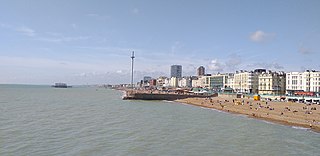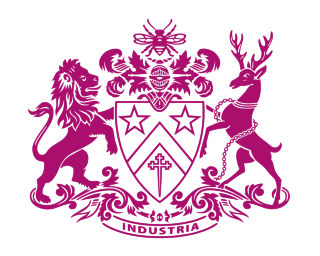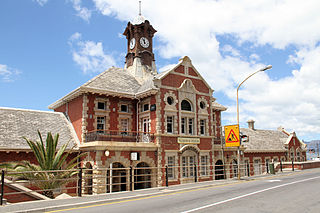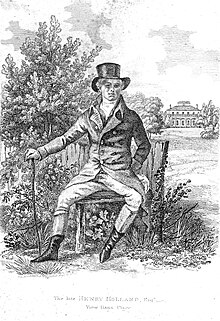
Brighton is a seaside resort and one of the two main areas of the City of Brighton and Hove. Located on the south coast of England, in the county of East Sussex, it is 47 miles (76 km) south of London.

The Royal Pavilion, and surrounding gardens, also known as the Brighton Pavilion, is a Grade I listed former royal residence located in Brighton, England. Beginning in 1787, it was built in three stages as a seaside retreat for George, Prince of Wales, who became the Prince Regent in 1811, and King George IV in 1820. It is built in the Indo-Saracenic style prevalent in India for most of the 19th century. The current appearance of the Pavilion, with its domes and minarets, is the work of architect John Nash, who extended the building starting in 1815. George IV's successors William IV, and Victoria, also used the Pavilion, but Queen Victoria decided that Osborne House should be the royal seaside retreat, and the Pavilion was sold to the city of Brighton in 1850.

Sir Hans Sloane, 1st Baronet, was an Anglo-Irish physician, naturalist, and collector, with a collection of 71,000 items which he bequeathed to the British nation, thus providing the foundation of the British Museum, the British Library, and the Natural History Museum, London. He was elected to the Royal Society at the age of 24. Sloane travelled to the Caribbean in 1687 and documented his travels and findings with extensive publications years later. Sloane was a renowned medical doctor among the aristocracy, and was elected to the Royal College of Physicians at age 27. He is credited with creating drinking chocolate. Streets and places were later named after him, including Hans Place, Hans Crescent, and Sloane Square in and around Chelsea, London – the area of his final residence – and also Sir Hans Sloane Square in his birthplace in Northern Ireland, Killyleagh.

Bexhill-on-Sea is a seaside town and civil parish situated in the county of East Sussex in South East England. An ancient town and part of the local government district of Rother, Bexhill is home to a number of archaeological sites, a Manor House in the Old Town, an abundance of Edwardian and Victorian architecture, and the famous De La Warr Pavilion: today a centre for contemporary art – which has featured the work of Andy Warhol, Cerith Wyn Evans and Richard Wilson among others – and an auditorium, where Bob Marley had his first UK appearance and has since seen performances by Elvis Costello, Goldfrapp, Ray Davies, Years & Years, Patti Smith and Laurie Anderson.

New Windsor is a town in Orange County, New York, United States.

Fettes College is a co-educational independent boarding and day school in Edinburgh, Scotland, with over two-thirds of its pupils in residence on campus. The school was originally a boarding school for boys only and became co-ed in 1983. In 1978 the College had a nine-hole golf course, an ice-skating rink used in winter for ice hockey and in summer as an outdoor swimming pool, a cross-country running track and a rifle shooting range within the forested 300-acre grounds. Fettes is sometimes referred to as a public school, although that term was traditionally used in Scotland for state schools. The school was founded with a bequest of Sir William Fettes in 1870 and started admitting girls in 1970. It follows the English rather than Scottish education system and has nine houses. The main building was designed by David Bryce.

Sloane Square is a small hard-landscaped square on the boundaries of the central London districts of Belgravia and Chelsea, located 1.8 miles (2.9 km) southwest of Charing Cross, in the Royal Borough of Kensington and Chelsea. The area forms a boundary between the two largest aristocratic estates in London, the Grosvenor Estate and the Cadogan. The square was formerly known as 'Hans Town', laid out in 1771 to a plan of by Henry Holland Snr. and Henry Holland Jnr. Both the square and Hans Town were named after Sir Hans Sloane (1660–1753), an Anglo-Irish doctor who, jointly with his appointed trustees, owned the land at the time.

Oxted is a town and civil parish in the Tandridge district of Surrey, England, at the foot of the North Downs. It is 9 miles (14 km) south south-east of Croydon in Greater London, 8.5 miles (13.7 km) west of Sevenoaks in Kent, and 9 miles (14 km) north of East Grinstead in West Sussex.

Henry Holland was an architect to the English nobility.

Muizenberg is a beach-side town in the Western Cape, South Africa. It is situated where the shore of the Cape Peninsula curves round to the east on the False Bay coast. It is considered to be the main surfing spot in Cape Town and is currently home to a surfing community, centered on the popular 'Surfer's Corner'.

Hans Place is a garden square in the Knightsbridge district of the Royal Borough of Kensington and Chelsea, London, immediately south of Harrods in SW1. It is named after Sir Hans Sloane, 1st Baronet, PRS, physician and collector, notable for his bequest, which became the foundation of the British Museum.

Cadogan Group Limited and its subsidiaries, including Cadogan Estates Limited, are British property investment and management companies that are owned by the Cadogan family, one of the richest families in the United Kingdom, which also holds the titles of Earl Cadogan and Viscount Chelsea, the latter used as a courtesy title by the Earl's eldest son. The Cadogan Group is the main landlord in the west London districts of Chelsea and Knightsbridge, and it is now the second largest of the surviving aristocratic Freehold Estates in Central London, after the Duke of Westminster's Grosvenor Estate, to which it is adjacent, covering Mayfair and Belgravia.
Charles Sloane Cadogan, 1st Earl Cadogan was a British peer and Whig politician.
Peter Frederick Robinson was an English architect.

Cadogan Place is a street in Belgravia, London. It is named after Earl Cadogan and runs parallel to the lower half of Sloane Street. It gives its name to the extensive Cadogan Place Gardens, private communal gardens maintained for Cadogan residents. It is owned by Cadogan Estates.
General Charles Cadogan, 2nd Baron Cadogan was an Anglo-Irish peer, soldier and Whig politician.

Winslade is a hamlet and civil parish in the Basingstoke and Deane district of Hampshire, England. It lies 3 miles (4.8 km) south of Basingstoke, just off the A339 road. The hamlet covers an area of 712 acres (288 ha) and has an average elevation of 550 feet (170 m). Its nearest railway station is Basingstoke, 4.2 miles (6.8 km) north of the hamlet. The parish of Winslade contains the vast Hackwood Park, an 89-acre (36 ha) Grade I listed Royal deer park. According to the 2011 census, Winslade, along with Tunworth, Weston Corbett and Weston Patrick, had a population of 224.

Holland House, originally known as Cope Castle, was an early Jacobean country house in Kensington, London, situated in a country estate that is now Holland Park. It was built in 1605 by the diplomat Sir Walter Cope. The building later passed by marriage to Henry Rich, 1st Baron Kensington, 1st Earl of Holland, and by descent through the Rich family, then became the property of the Fox family, during which time it became a noted gathering-place for Whigs in the 19th century. The house was largely destroyed by German firebombing during the Blitz in 1940 and today only the east wing and some ruins of the ground floor and south facade remain, along with various outbuildings and formal gardens. In 1949 the ruin was designated a grade I listed building and it is now owned by the Royal Borough of Kensington and Chelsea.

French and British interregnum in the Dutch East Indies were a relatively short period of French and followed by British interregnum on the Dutch East Indies that took place between 1806 and 1816. The French ruled between 1806 and 1811. The British took over for 1811 to 1816, and transferred its control back to the Dutch in 1816.
Fulke Rose was a British physician and early colonist of Jamaica. He was one of the principal buyers in Jamaica of slaves taken by the Royal African Company and had extensive land-holdings on the island. He continued to practice medicine in Jamaica and with Hans Sloane attended the former privateer Henry Morgan towards the end of Morgan's life.
















